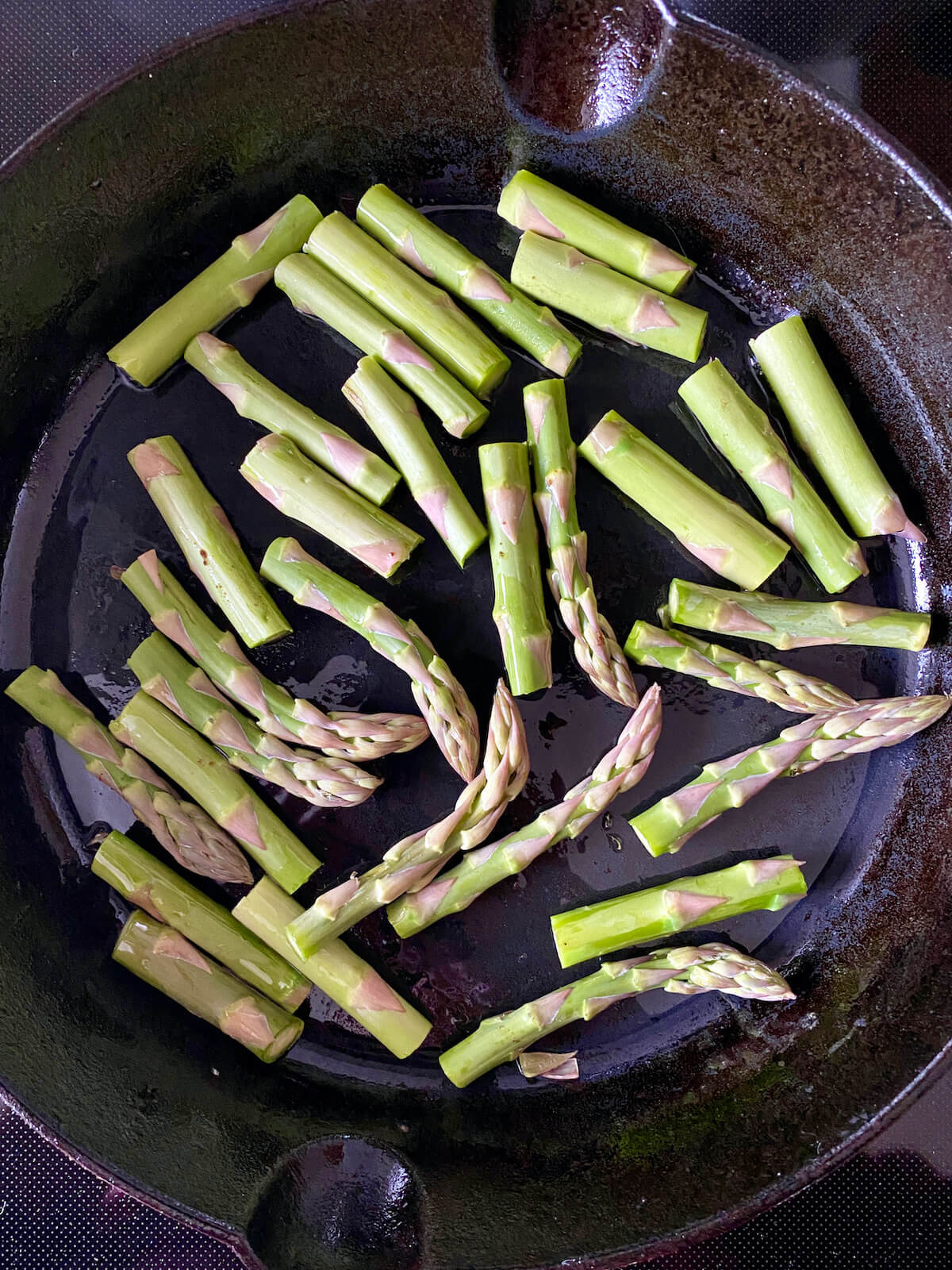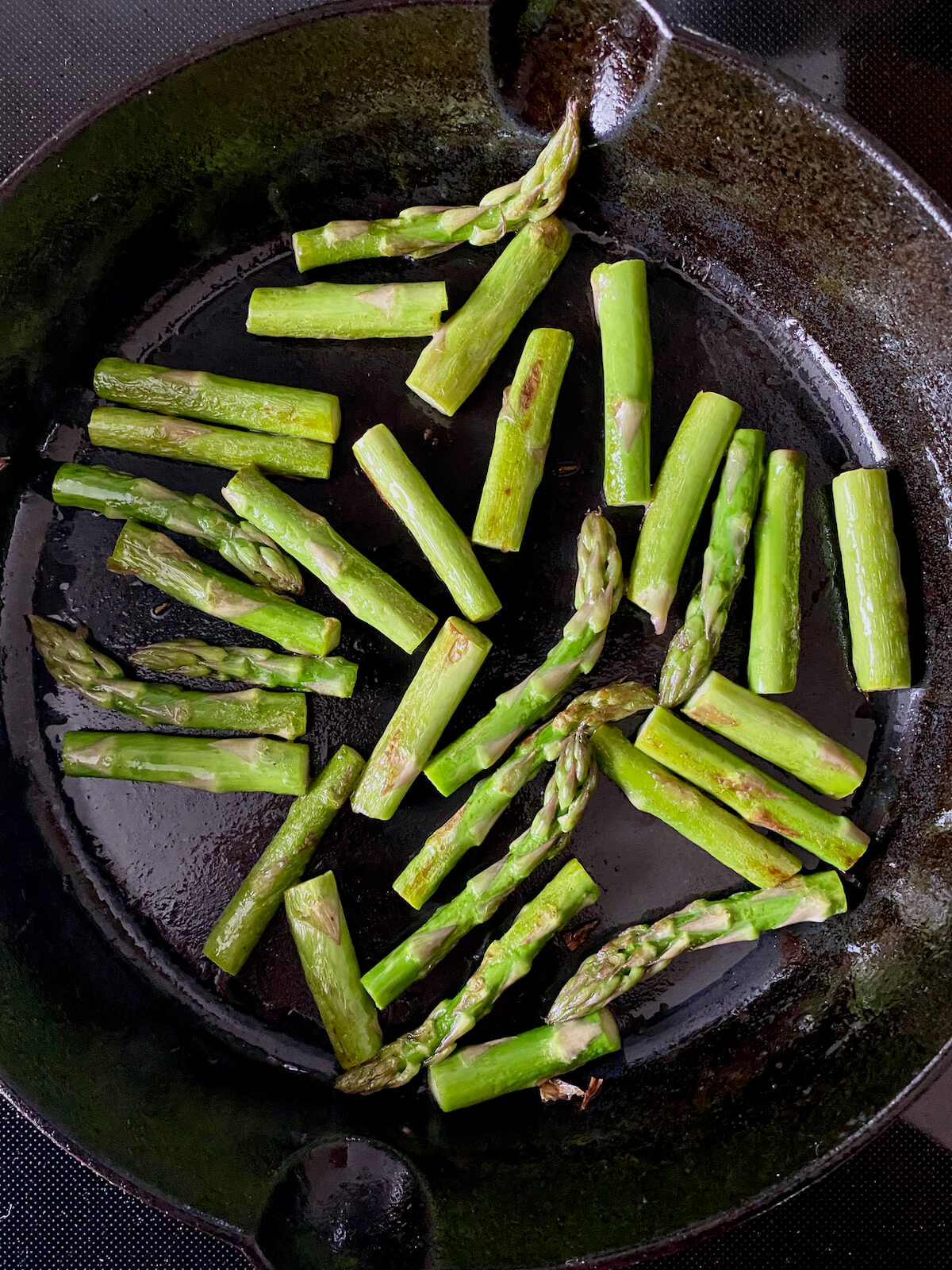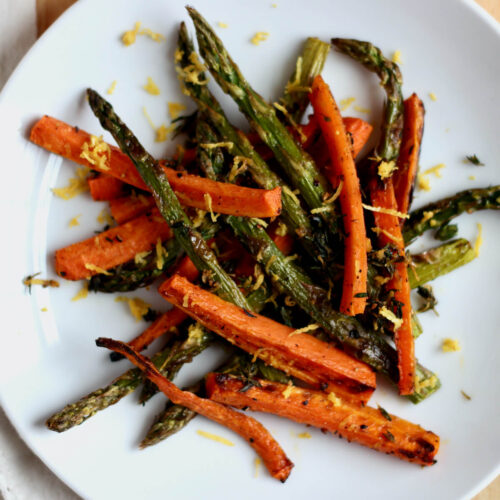This Cast Iron Asparagus is the perfect vegetable side dish for all of your seasonal spring meals. Ready in just 15 minutes and made with only 9 ingredients, this healthy sautéed asparagus is seasoned well with butter, garlic, lemon, and red pepper flakes. Gluten-free, low-carb friendly.

If boiled, bland, and boring is how you'd describe your vegetable game, fear not! I'm here to show you how quick and simple it is to jazz up your vegetable side dishes and take them from 'meh' to 'wow!'
Often, vegetables are an afterthought at the dinner table. We spend all of our time making sure the main dish is seasoned to perfection, then feel uninspired when it comes to the veggies.
But, I think vegetables should be just as jam-packed with flavor as the rest of the meal. And this cast iron skillet asparagus is no exception.
Seasoned generously with both fresh garlic and garlic powder, lemon zest, red pepper flakes, and butter, this easy asparagus recipe is the perfect companion for all of your springtime meals. And the best part? It's ready in just 15 minutes!
So, grab some fresh asparagus at the market, maybe open a bottle of wine, and let's get cooking!
Disclaimer: Some links throughout this post are affiliate links. As an Amazon Associate, I earn from qualifying purchases. You can learn more by visiting my Affiliate Disclosure Page.
Why You'll Love This Recipe
- Ready in 15 Minutes- Asparagus is one of my favorite vegetables because it's easy to cut and cooks super quickly. In just a few minutes, you'll have the perfect spring vegetable side dish ready for dinner.
- Only 9 Ingredients- Most ingredients are pantry staples, making this lemon garlic asparagus recipe easy to whip up any night of the week.
- Perfect for Spring- Every spring season, I look forward to taking advantage of all the fresh and flavorful asparagus at the grocery store.
- Healthy- Full of fiber, vitamins, and minerals, cast iron asparagus is a side dish you can feel good about serving to your family.
- Flavorful- Buttery, garlicky, lemony, and with just a hint of spice, this sautéed asparagus is well-seasoned and delicious.
Ingredient Notes
Here are some notes on the key ingredients. For the full list of ingredients, check out the recipe card below.
- Asparagus- Look for bright green, firm, and uniform asparagus stalks. I prefer to cut the asparagus into 3-inch pieces for easier sautéing and eating.
- Garlic- This recipe uses both fresh garlic and garlic powder for extra flavor. Use either grated or minced garlic so it cooks quickly in the butter.
- Lemon Zest- Just a small amount of lemon zest brightens this dish up with a pop of fresh citrus flavor.
- Olive Oil- The asparagus is cooked first in olive oil so we can get it nice and caramelized. I use light olive oil instead of extra virgin olive oil because it has a higher smoke point.
- Butter- A little butter is added at the end for flavor.
- Garlic Powder- Gives the asparagus an extra garlicky flavor.
- Red Pepper Flakes- Adds a little bit of heat and the flavor pairs well with lemon and garlic.
- Kosher Salt- Season to taste.
- Black Pepper- Use freshly ground black pepper for the best flavor.
🌱 Sustainability Tip: Reduce food waste by saving the asparagus ends, lemon pieces, and garlic skins to make homemade vegetable broth or chicken stock.

How to Tell If Asparagus Is Bad
Asparagus is a tender vegetable that goes bad rather quickly. If you're unsure, look for these telltale signs that your asparagus has gone bad.
- Check the Tips- The tips of asparagus are the most tender part of the vegetable. And therefore, the tip is usually the first part to go bad. Asparagus tips that are mushy, slimy, dark, and smelly indicate the vegetable is past its prime.
- Mold- Visible mold is an obvious indicator that your asparagus should be tossed.
- Smell- Fresh asparagus should smell slightly grassy and earthy. If it smells rotten, rancid, or sour, it has likely gone bad.
- Texture- Asparagus should be firm and crisp. Limp, rubbery, or mushy asparagus should be discarded.
Substitutions and Variations
Here are a few ways you can try customizing this sautéed cast iron asparagus recipe to fit your diet and taste preferences.
Substitutions
- Asparagus- Swap fresh asparagus for frozen asparagus if preferred. Keep in mind that frozen asparagus may take a few minutes longer to cook.
- Garlic- Use an additional ½ teaspoon of garlic powder in place of fresh garlic cloves.
- Lemon Zest- Squeeze lemon juice over the asparagus instead of using lemon zest for a less intense lemon flavor.
- Olive Oil- Substitute the olive oil with any high-heat, neutral-flavored cooking oil.
- Butter- Replace butter with margarine or dairy-free butter if preferred.
- Seasonings- Season this pan-roasted asparagus any way you'd like. Add herbs, onion powder, cayenne pepper, chili powder, etc. Get creative!

Variations
- Cheesy- Sprinkle some grated parmesan cheese over the asparagus after it finishes cooking for a cheesy flavor.
- Herbs- Add fresh or dried herbs for a bright, herbaceous flavor.
- bacon- Crumbled bacon elevates the texture and flavor of the dish.
- Slivered Almonds- Toasted almonds add a crunchy texture and nutty flavor that pairs well with asparagus.
- Glazed- Drizzle a little honey, maple syrup, or balsamic vinegar reduction over the pan-seared asparagus with garlic for a hint of sweetness.
Equipment Notes
Here are some notes on any special equipment I used to make this recipe.
- Cast Iron Skillet- A well-seasoned cast iron skillet is a great tool for cooking asparagus to perfection. Because it's naturally non-stick, the asparagus won't stick to the pan or become mushy. Plus, cast iron's ability to retain heat evenly allows us to achieve beautifully charred asparagus without overcooking it.
How to Make Cast Iron Asparagus
Here is how to make lemon garlic asparagus in a cast iron skillet.
Step 1: Sauté the asparagus. Heat olive oil in a well-seasoned cast iron skillet over medium heat. Add the asparagus to the skillet. Cook, stirring occasionally, until tender and lightly browned, about 5-7 minutes.


Step 2: Season the asparagus. Add butter, garlic, lemon zest, and seasonings to the skillet. Sauté for an additional 30-60 seconds and remove from heat. Serve immediately.

Tips for Success
- Choose the right asparagus. Look for fresh asparagus spears that are bright green, firm, and uniform in thickness.
- Preheat the skillet. Allow the cast iron pan enough time to fully heat up before adding the asparagus.
- Don't overcook the asparagus. Asparagus quickly goes from perfectly tender to mushy when overcooked.
- Serve immediately. Cast iron asparagus is best when hot and freshly cooked.
What to Serve With Cast Iron Asparagus
Sautéed cast iron asparagus is a fantastic vegetable side dish that pairs well with just about any spring meal. I love serving sautéed garlic asparagus with whole oven-roasted chicken and mashed potatoes.
Here are a few other recipes to serve with pan-fried asparagus:

How to Use Up Leftover Cast Iron Asparagus
Sautéed asparagus with garlic and lemon is easy to repurpose into a variety of other dishes.
Asparagus pairs particularly well with eggs and is delicious in a quiche or frittata. Another option is puréeing the cooked asparagus into soup, like in this Broccoli Asparagus Soup recipe.
Alternatively, cast iron asparagus can be used on top of a fresh salad or in a vegetable sandwich for a fun and healthy lunch. Finally, top a homemade pizza with some pan-fried asparagus or mix it into your favorite pasta dish or stir-fry recipe.
Storage and Reheating
How to Store
- Refrigerator- Store leftover cast iron asparagus in an airtight container in the refrigerator for 3-5 days.
- Freezer- For longer storage, freeze leftover sautéed asparagus in a freezer-safe container for up to 3 months.
💡 Did You Know? To keep your asparagus fresher for longer, all you need to do is store it upright in the fridge in a little bit of water. This can help it last up to a whole week!
How to Reheat
- Oven- Preheat the oven to 350ºF. Toss the leftover asparagus with a little bit of olive oil if it seems dry and spread it evenly on a baking sheet. Roast the asparagus for 5-10 minutes or until fully warmed through.
- Stovetop- Add a small amount of oil or butter to a skillet over medium-low heat. Add the leftover cast iron asparagus and pan fry for 4-5 minutes or until heated through.
- Microwave- Spread leftover pan-fried out evenly on a microwave-safe dish. Cover with a damp paper towel and heat on HIGH in 30-second intervals until hot.
- Air Fryer- Preheat the air fryer to 375ºF. Arrange the leftover sautéed asparagus in the air fryer basket in a single layer and cook for 2-3 minutes, shaking the basket halfway through.

Frequently Asked Questions
Sometimes recipes recommend holding an asparagus spear on each end and snapping it in half. Supposedly, wherever the asparagus snaps is where the woody end starts. However, this isn't exactly true. For less waste, I recommend using a knife to trim the ends where they start to fade to white.
No, there is no need to soak asparagus before sautéing it. Simply give it a quick rinse and pat it dry before cooking.
Sautéing asparagus in a cast iron skillet is one of the best ways to cook and eat asparagus. Not only is it flavorful and delicious, but there are fewer nutrients lost using this cooking method.
Asparagus is a tender vegetable that overcooks quickly if you're not careful. If your asparagus turned out soggy or mushy, try cooking it for a minute or two less next time. Also, removing it from the heat quickly ensures it doesn't continue cooking in the pan.
Let's Connect!
Be sure to leave a comment below if you have any questions. You can also connect with me on Instagram, Facebook, Pinterest, or via email at [email protected].
📖 Recipe
Cast Iron Asparagus
Equipment
Ingredients
- 1 tablespoon olive oil
- 1 bunch asparagus ends trimmed, cut into 3-inch pieces
- ½ tablespoon unsalted butter
- 2 cloves garlic minced or grated
- Zest from ½ of a lemon
- ½ teaspoon garlic powder
- ½ teaspoon kosher salt
- ½ teaspoon black pepper
- ¼ teaspoon red pepper flakes
Instructions
- Heat olive oil in a well-seasoned cast iron skillet over medium heat. Add the asparagus to the skillet. Cook, stirring occasionally, until tender and lightly browned, about 5-7 minutes.1 tablespoon olive oil, 1 bunch asparagus
- Add butter, garlic, lemon zest, and seasonings to the skillet. Sauté for an additional 30-60 seconds and remove from heat. Serve immediately.½ tablespoon unsalted butter, 2 cloves garlic, Zest from ½ of a lemon, ½ teaspoon garlic powder, ½ teaspoon kosher salt, ½ teaspoon black pepper, ¼ teaspoon red pepper flakes
Notes
- Storage: Store leftovers in the refrigerator for up to 5 days or in the freezer for up to 3 months.
- Make Ahead: Cut the asparagus up to 3 days before cooking and store it in the refrigerator.









Sue says
Why don't you take the unusuable ends and blend them in a vitamix to make a wonderful soup with Real cream . That works well for me. A bit of onion makes it even better. I fixed asparagus every day from the time it 1st grows up until it's over.
Ashley Petrie says
Hi Sue! I've never tried that, but it sounds like a great way to reduce food waste. Thanks for the idea! 🙂